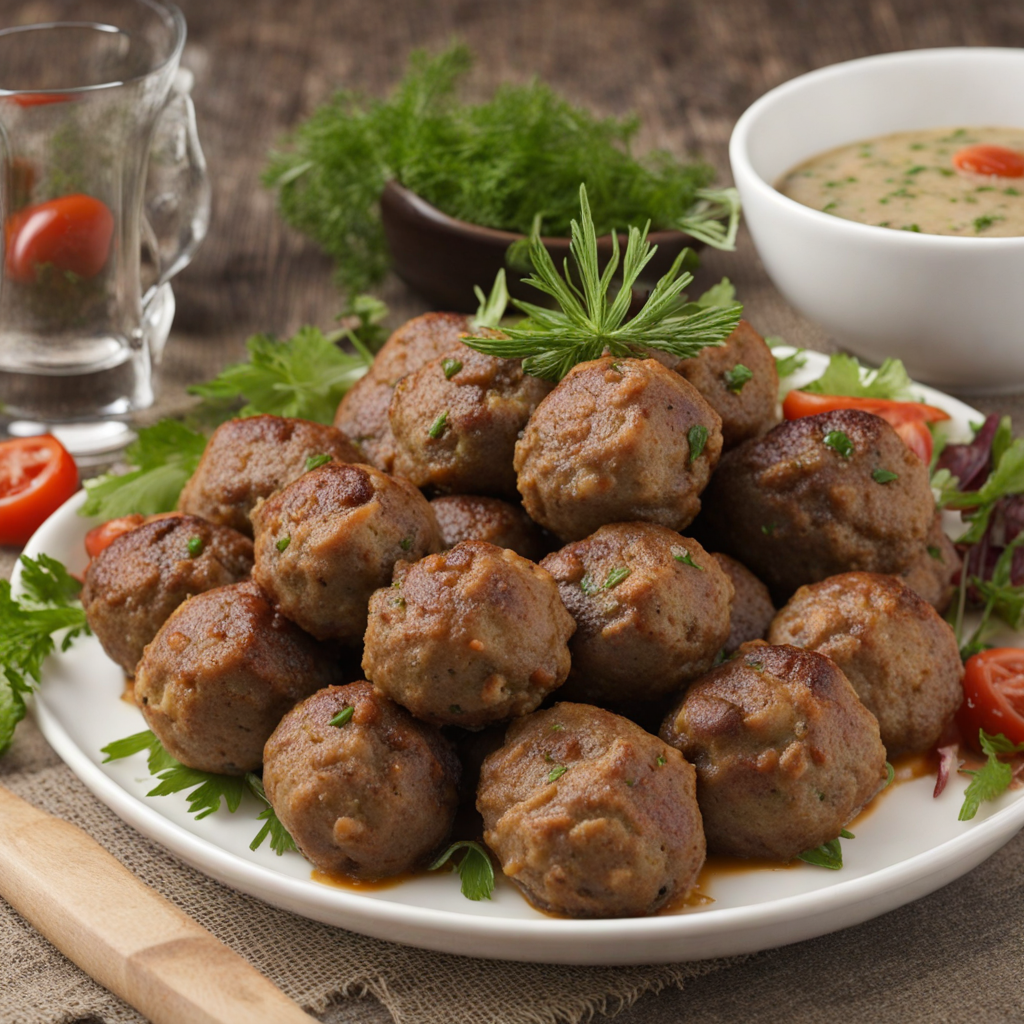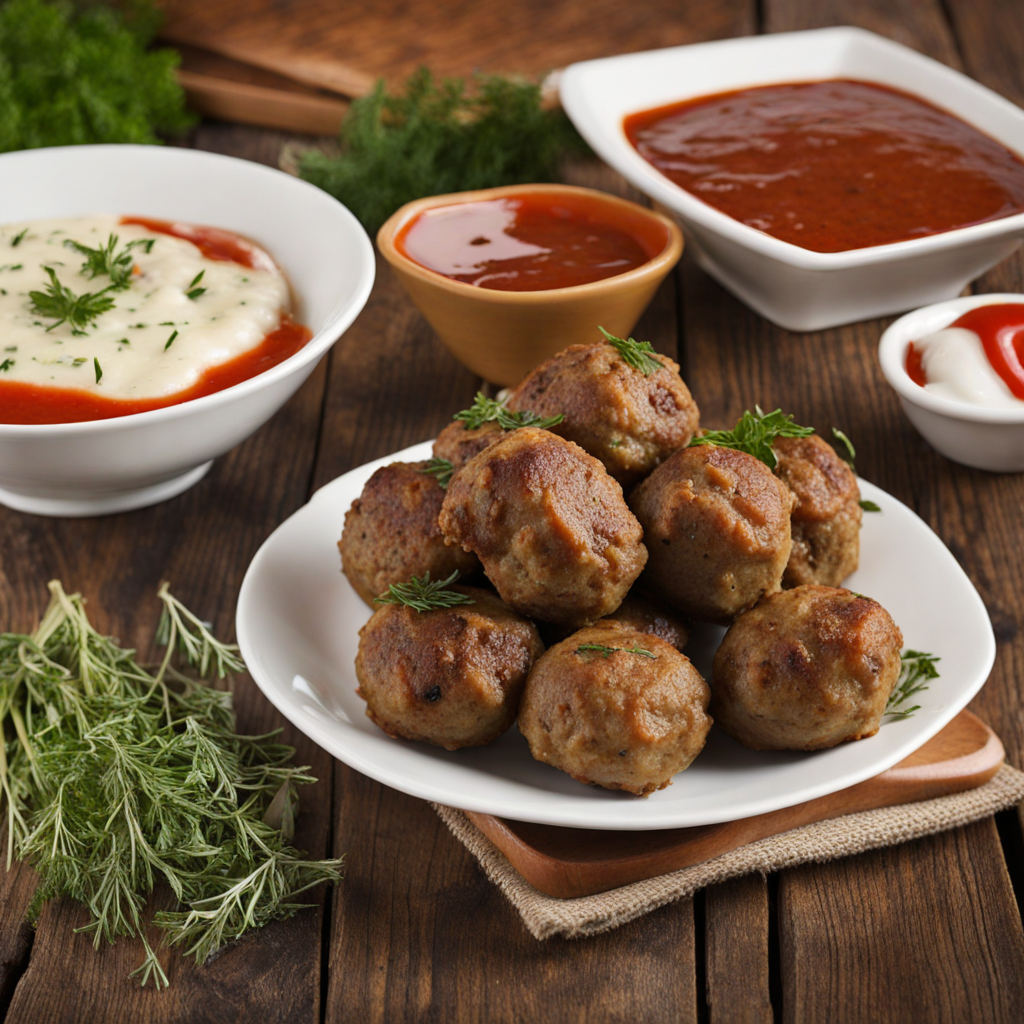Keftedes
Keftedes are a delightful culinary gem from Cyprus, embodying the island's rich Mediterranean flavors. These aromatic meatballs are typically made from a savory mixture of minced meat, often lamb or beef, blended with herbs and spices such as mint, parsley, and garlic. This harmonious combination creates a robust flavor profile that is both comforting and enticing, making Keftedes a popular choice among locals and visitors alike. The use of fresh ingredients, particularly herbs, elevates the dish, giving it a vibrant and fragrant character that reflects the bounty of the Cypriot landscape. When prepared, Keftedes are usually shaped into small, round balls and pan-fried until golden brown. This cooking method not only enhances their flavor but also adds a delightful crispy texture on the outside, while the inside remains juicy and tender. They are often served with a side of tzatziki, a refreshing yogurt-based sauce infused with cucumber and garlic, which complements the richness of the meatballs perfectly. The contrast of textures and flavors creates a satisfying eating experience that is both hearty and refreshing. Enjoying Keftedes is an invitation to explore the communal aspect of Cypriot dining. These meatballs are often served as part of a meze platter, alongside a variety of other dishes, allowing diners to indulge in a feast of different tastes and textures. Sharing Keftedes with friends and family enhances the enjoyment, as the flavors mingle and the experience becomes a celebration of culinary tradition. Whether enjoyed as a main dish or as part of a larger spread, Keftedes are sure to leave a lasting impression on anyone eager to discover the vibrant flavors of Cypriot cuisine.
How It Became This Dish
The History of Κεφτέδες: A Culinary Journey Through Cyprus #### Origins and Etymology Κεφτέδες, or "keftedes," are a beloved staple of Cypriot cuisine, embodying the island's rich tapestry of cultural influences and culinary traditions. The word "keftedes" is derived from the Arabic term "kufteh," which refers to ground meat mixed with spices, herbs, and other ingredients, shaped into balls or patties. This etymology hints at the dish's deep-rooted connections to the Levant and the Middle East, where variations of meatballs have been enjoyed for centuries. The origins of keftedes can be traced back to ancient Greece and the broader Mediterranean region, where minced meat dishes have been a part of local diets since antiquity. Historical accounts suggest that the Greeks brought this concept to Cyprus, where it evolved and incorporated local ingredients and flavors. The dish reflects the island's historical significance as a crossroads of civilizations, where Greek, Turkish, and Arab influences melded together, creating a unique culinary identity. #### Cultural Significance Keftedes are more than just a dish; they hold a special place in Cypriot culture and tradition. Often served as part of a meze—a selection of small dishes meant for sharing—keftedes symbolize hospitality and communal dining, which are cherished values in Cypriot society. They are commonly prepared for family gatherings, celebrations, and festive occasions, embodying a sense of warmth and togetherness. In Cyprus, the preparation of keftedes is often a communal activity, involving family members in the mixing, shaping, and frying processes. Each household may have its own secret recipe, passed down through generations, which adds to the dish's personal significance. This familial connection is mirrored in the broader Cypriot culture, where food plays a pivotal role in social bonding and cultural identity. #### Ingredients and Variations Traditional keftedes are typically made from minced lamb or beef, mixed with breadcrumbs, herbs, and spices such as mint, parsley, and cumin. The use of fresh herbs is particularly important, as they impart flavor and aroma, making each bite a sensory delight. Some recipes also incorporate grated onions, garlic, and even grated potatoes to enhance the texture and moisture of the meatballs. While the basic recipe remains consistent, regional variations abound, reflecting the diverse agricultural landscape of Cyprus. For instance, in coastal areas, seafood keftedes made from fish or shrimp are popular, while mountainous regions may feature keftedes prepared with game meat. Vegetarian versions have also emerged, incorporating lentils or chickpeas as the base, catering to modern dietary preferences. #### The Evolution of Keftedes Over the centuries, the preparation and presentation of keftedes have evolved alongside changing culinary trends and influences. In the early 20th century, as Cypriots began to migrate to urban areas, the dish adapted to accommodate the fast-paced lifestyle of city living. Keftedes became a popular street food, sold by vendors and enjoyed by locals and tourists alike, often served with a side of tangy tahini sauce or fresh salad. The rise of tourism in Cyprus during the mid-20th century further popularized keftedes, leading to their inclusion in restaurant menus and international culinary repertoires. Chefs began to experiment with innovative presentations and pairings, introducing keftedes served in wraps, on skewers, or as part of fusion dishes that blend Cypriot flavors with global cuisines. In contemporary Cypriot gastronomy, keftedes continue to thrive as a beloved comfort food. They are often featured at family gatherings, picnics, and barbecues, celebrated for their versatility and ease of preparation. The growing interest in sustainable and local eating has also led to a resurgence in traditional recipes, with many families returning to their roots by using locally sourced ingredients and time-honored techniques. #### Keftedes in the Global Context The international popularity of keftedes reflects a broader trend of rising interest in Mediterranean cuisine, known for its health benefits and diverse flavors. As people around the world seek authentic culinary experiences, keftedes have emerged as a symbol of Cyprus's gastronomic heritage, celebrated for their simplicity and rich flavors. In the global culinary landscape, keftedes can be found in various forms—be it in Middle Eastern restaurants as "kebabs," in Greek tavernas as "keftedes," or even in contemporary fusion eateries. This adaptability demonstrates the dish's universal appeal and its ability to resonate with diverse palates. Moreover, the rise of food festivals and cultural events celebrating Cypriot cuisine has contributed to the growing recognition of keftedes as a culinary treasure, drawing food enthusiasts eager to explore the island's gastronomic offerings. #### The Future of Keftedes As the culinary world continues to evolve, the future of keftedes looks bright. Chefs are increasingly experimenting with plant-based alternatives, creating innovative vegan and vegetarian versions that maintain the essence of the dish while catering to modern dietary preferences. This evolution speaks to a broader trend in gastronomy, where traditional dishes are reimagined to meet contemporary tastes and values. Furthermore, the emphasis on sustainability and local sourcing is likely to continue shaping the future of keftedes. As more people become aware of the importance of supporting local farmers and producers, the emphasis on fresh, seasonal ingredients will enhance the authenticity and flavor of this classic dish. #### Conclusion Keftedes are more than a simple meatball; they are a culinary symbol of Cyprus's rich history, cultural diversity, and communal spirit. From their ancient origins to their modern adaptations, keftedes embody the island's vibrant gastronomic heritage, inviting people to savor not just the flavors but also the stories and traditions that accompany each bite. As they continue to evolve and adapt to the changing culinary landscape, keftedes will undoubtedly remain a cherished part of Cypriot culture, celebrating the island's rich history and the bonds that food creates among communities.
You may like
Discover local flavors from Cyprus






